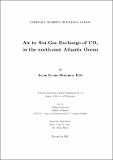| dc.description.abstract | Atmospheric carbon dioxide concentrations have been rising for the past 200 years, and started increasing at a faster rate during the last 60 years. The world's oceans act as a reservoir for large amounts of CO_2. How they will respond to increasing atmospheric concentrations of carbon dioxide is unknown. It is imperative that the movement of CO_2 between the air and the ocean is unequivocally understood.
Sea-water pCO_2 concentrations were measured in the north-east Atlantic Ocean off the island of Ireland, using a Pro-Oceanus CO_2 Pro pCO_2 instrument. The sensor was installed on the R.V. Celtic Explorer during 2010. The accuracy of the instrument was examined by bench-marking the sensor through a series of methods. Once completed, pCO_2 data collected by the instrument was analysed. CO_2 concentrations in the atmosphere remained stable throughout the year, while sea-water CO_2 concentrations varied on an seasonal basis. They were highest during the spring and winter months, whilst lowest during the summer months. This indicates that sea-waters off Ireland are most likely a sink for carbon dioxide during the summer months and are possibly a weak source in winter. Biological activity was the the main driving force behind the variation of carbon dioxide in the oceanic environment off Ireland.
Sea-water pCO_2 concentrations were also measured at Mace Head, Co. Galway, by installing a Pro Oceanus CO_2 Pro pCO_2 instrument on an all-weather buoy. During the winter of 2008/2009, sea-water pCO_2 concentrations were less than atmospheric concentrations and during the summer months of 2009, CO_2 concentrations in the ocean were highly variable, yet substantially higher than CO_2 concentrations in the over-lying air. CO_2 flux measurements were also conducted at Mace Head. Both of these data sets indicated that the coastal environment at Mace Head was a sink for carbon dioxide during the winter of 2008/2009 and a source of CO_2 during the summer months, in contrast to open ocean waters. CO_2 fluxes were corrected for cross-sensitivity and temperature effects. A negative correlation was calculated for the relationship between wind speed and CO_2 fluxes.
Gas transfer velocity values for CO_2 were also calculated at Mace Head. As wind speed increased, so did the CO_2 transfer velocity. This is in agreement with past experimental work. However, the dependence on wind speed was not as strong as calculated from past research. There was a lack of gas transfer velocity data at higher wind speeds, but this is a frequent issue when studying the wind speed/gas transfer velocity relationship. | en_US |


